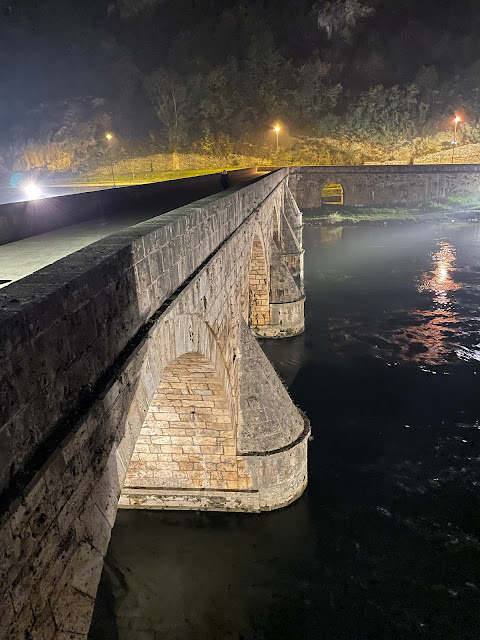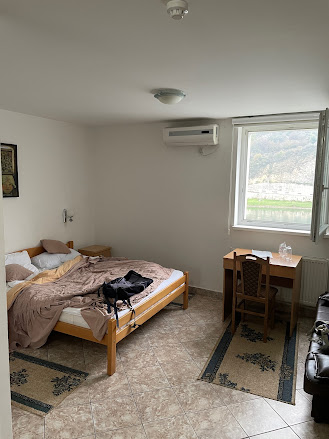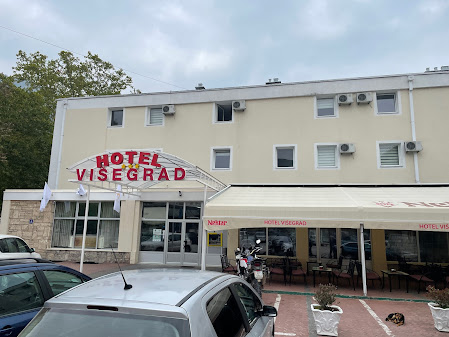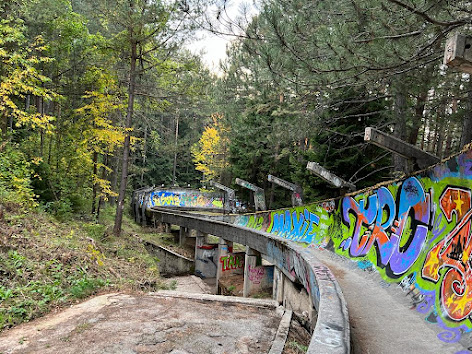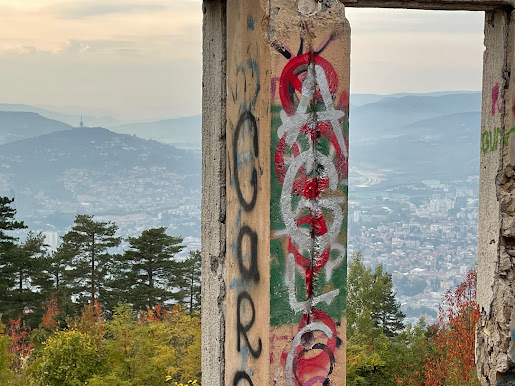The train to Sarajevo rolls through the most amazing
scenery; rivers, gorges, lakes forests and mountains. The brutal communist-era
stations at either end stand in stark contrast the flowing beauty found between
them. Communist architects (of all types) seemed to love huge statements in concrete
– and to prefer function over form. Clearly beauty was seen as an unnecessary
decadence. In Tito’s day trains left for all over Yugoslavia, but current
attempts to revive some of the connections falter at the boundaries of
bureaucracy and mistrust. The vast stations sit empty for much of the day –
miles of trackbed rusts silently all over the former Yugoslavia.
Bosnia and Herzegovina is divided into two parts. The
Bosnia-Herzegovina federation and Republika Srpska. Crossing from Bosnia to RS
has no international boundary and no passport control – it is all ruled from
Sarajevo. Yet it the “Welcome to Republika Srpska” sign is in English, Russian,
and several other languages – but not in Croatian/Bosnian. This is chilling
because it was here that Karadzic and Mladic pursued the worst of the so-called
‘ethic cleansing.’ We saw a village where a mosque was left, but surrounded by
smashed and overgrown houses surrounding it. What horrors happened here?
Travelling across the Balkans is to visit countless
memorials and museums remembering violence, horror and depravity; cycles of
hate and retribution stretching back centuries. 8,372 is an enormous number,
but each individual life lost matters greatly, and no amount of 'whataboutery'
can reduce the truth of that - or should reduce the life sentences of those
(wretchedly few) who were convicted of war crimes.
As a Christian, standing quietly paying my respects in this
Islamic cemetery I felt physically sick at the thought that the perpetrators of
these crimes claimed loyalty to the Serbian Orthodox Church. Utter disgust.
Followers of Jesus must 'love their enemies' and 'bless those who persecute
them' - according to Jesus. It is a stark reminder that
"christianity" without Jesus can become monstrous. “I'm baptised in
your prejudice, I'm confirmed with your hate, I'm ordained into violence” John
Lees raged in his lyrics. "Jesus Wept".
Simply as a human, I could not comprehend the stories.
"we grew up with them, we went to school with them, we traded with them,
and played football with them - and then they rose up and slaughtered us".
I read stories like this, across the Balkans from all sides of the wars of the
1990s. How can this be? How can you murder half your own school football team?
The depths of the wickedness of humanity is greater than I had faced since I
stood in Berlin's Jewish Holocaust Memorial. Lord have mercy.
I will never forget Srebrenica.
The River Drina is a stunning water-course, one of the great
rivers of South Eastern Europe. Its huge catchment area funnels masses of water
down towards the Adriatic through a vast, spectacular gorge. It’s not as well-known
as some rivers – but it should be. Here, today Serbia borders Bosnia. Over
countless centuries it has also been the boundary between Catholicism and
Orthodox – and between Christendom and Islamic power. It is said that it is foolish
to live on a geographical fault-line, and what is usually meant by that comes
from the world of physical Geography. It is probably more true in the world of
political geography – for this fault line has seen many tremors and crises.
In Visigrad, a town famous for its beautiful and ancient bridge – the 1990s seem like very recent history indeed. Our communist-era hotel was stark in its’ aesthetic-free functionality – and was full of tobacco smoke, old men and suspicious looks. Old enmities die hard, but so do old friendships and Croatia is full of German number-plated cars, but in Serb areas, Russian cars were everywhere. Ivo Andric’s Nobel-winning “The Bridge on the Drina” is set here – and one can only think it is a mercy that he died before seeing the bridge become a slaughterhouse for Bozniaks in the early 1990s. It’s said the river ran red, and the hydro-electric power station got clogged with bodies at the height of the carnage. Yet, in a juxtaposition perhaps indicative of the contradictions in the human condition, we had a charming meal out – at scandalously cheap prices, from smiling friendly staff, joyful to teach us some of their language – while we passively smoked a thousand cigarettes.
Our first attempt to make it into Montenegro was unsuccessful. The mountain road that Google maps insisted was the correct route got increasingly precarious. As it narrowed and contorted, the surface fractured and our progress slowed to such a rate that we gave up and hammered our way South on better roads within BiH. When we finally found a remote border crossing post, the guard looked at us incredulously and said, “You want Montenegro?!” Indeed we did – and after stamping our passports on the wrong page, he let us through; far more quickly we noted than the huge shiny Russian number-plated Range Rover before us. Tiny Montenegro we soon discovered was much more wealthy and touristy than Republika Srpska, its beautiful Adriatic coastal towns having stunning old cities and garish resorts at every turn. The mountainous interior is very sparsely populated, the rocky ground is hard to farm, and the gradients severe. It is a stunningly beautiful country too. At the apartment the landlord welcomed us with plum Rakija and we soon discovered that we spoke a language in common….. football. Walking is a delight in Montenegro too, because while it was firmly allied to Serbia throughout the wars of the 1990s, there was very little fighting there, and so almost no risk of mines. The Adriatic in these parts is teeming with fish, and the seafood restaurants are wonderful. Even in the harbours, we watched small children and old grandpa’s pulling good fish from the water simply by lowering a single baited line off the side.
Our Balkan odyssey came to end with a long drive through
Croatia, tracing its’ stunning coastline past Cavtat, Dubrovnik, Split and to
our final destination in Zadar. Tito, of course, had been a Croatian – and it
was interesting to speak to two older ladies who recalled him with a fondness
that bordered on idolatry. His propaganda department had not wasted their
efforts on these two, when they were girls. While acknowledging that he’d
murdered many opponents, especially in the 1940s, they had both been to his
grave to pay their respects to the man and his ‘golden era’ of their childhood.
“I thought the world would end when he died” I was told. Titograd has long been
renamed Visigrad, but the man lingers on as a living myth.
As I lookback on our Balkan exploration, so many images
jostle for my attention. The bomb damage in Mostar, the old bridge there too.
The stunning mountains. The Bridge on the Drina. Sarajevo City and the Olympic
Park. The mountains of Monetenegro. Sunset over the Adriatic. The little church
we went to in Mostar where our friend from Burnley led the singing in Croatian.
Srebrenica. And in the background, Les Holroyd’s voice lamenting, “Nothing’s Going to Change, Nothing’s Going
to Change”. But is he right? Optimists point out that Croatia is booming in
the EU, and is a stable, wealthy tourist destination. Montenegro appears to be
heading that way too. Serbia’s desire to enter the EU would further promote
integration. Bosnia Herzegovina has enjoyed the peaceful stalemate for a
quarter of a century. Pessimists want to assert that conflict in the Balkans is
never extinct, only ever dormant and that the historical tensions will
inevitably boil over into violence again one day.
There is a prayer on a plaque in Srebrenica that says, “May Srebrenica happen to no one else, ever anywhere.” If the optimists are right, then these lessons will be grasped. But if the pessimists are, then “Nothing’s going to change”. Another John Lees lyric sums it up, “Please lay down your pistols and your rifles…… God alone knows how we will survive”.
















